Magazine design is a crucial element in captivating readers, and its visual appeal plays a significant role in drawing and retaining attention. The design of a magazine goes beyond merely presenting content; it creates an experience that guides the reader through a visual and intellectual journey. At the heart of effective magazine design is the use of layout and typography to create a hierarchy that makes content easy to navigate and engaging. The strategic placement of headlines, subheadings, and body text helps in breaking down complex information into digestible segments, making the reading experience smoother and more enjoyable. Imagery is another critical aspect of magazine design that significantly impacts visual appeal. High-quality, relevant images attract readers and enhance the textual content, providing a visual representation of the article’s subject matter. For instance, a travel magazine might use stunning photographs of destinations to entice readers and evoke a sense of wanderlust.

The choice of images, their placement, and their size are meticulously considered to create a cohesive visual narrative that complements the written content. Color schemes and design elements further contribute to a magazine’s allure. The selection of colors is often aligned with the magazine’s theme and target audience, creating an aesthetic that resonates with readers. For example, a fashion magazine might use bold, vibrant colors to reflect current trends, while a lifestyle magazine may opt for softer, more muted tones to convey a sense of calm and sophistication. Consistency in color palettes and design elements across the magazine ensures a harmonious look that enhances readability and visual appeal. The use of white space, or negative space, is also a key factor in magazine design. White space helps in balancing the page and preventing it from appearing cluttered. It provides visual breathing room, allowing readers to focus on the content without feeling overwhelmed.
Effective use of white space can guide the reader’s eye through the layout and highlight important elements, such as key articles or features. Additionally, the choice of fonts and typography greatly influences the magazine’s aesthetic. Magazine’s for world fonts convey different moods and styles, and selecting the right ones can reinforce the magazine’s brand identity. A magazine dedicated to classic literature might use serif fonts to evoke a sense of tradition and elegance, while a contemporary lifestyle magazine might opt for clean, sans-serif fonts to project modernity and simplicity. Overall, magazine design is a dynamic interplay of layout, imagery, color, typography, and white space. Each element must work in harmony to create a visually appealing and engaging product that captures the reader’s attention and enhances their reading experience. The success of a magazine often hinges on its ability to not only present information but to do so in a way that is both aesthetically pleasing and intellectually stimulating.
